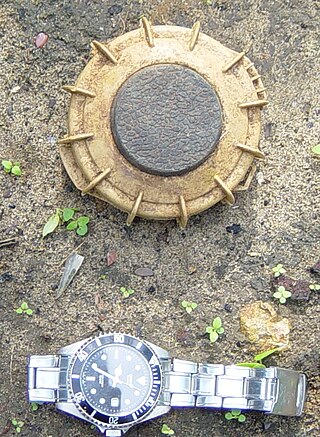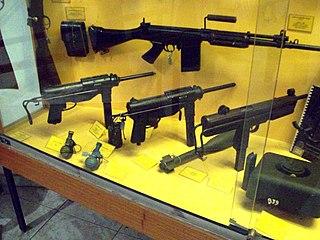Related Research Articles

The VS-2.2, VS-3.6 and SH-55 are Italian circular plastic cased anti-tank blast mines that use the VS-N series fuze. They have very few metal components and are resistant to overpressure and shock. The VS-2.2 and VS-3.6 can also be deployed from helicopters. It was produced by Valsella Meccanotecnica and Singapore, but production has ceased. The VS-2.2 and VS-3.6 are essentially the same, the VS-3.6 being slightly larger, the SH-55 is larger still and has a more rounded appearance. A smaller mine, the VS-1.6 also uses the same fuze.

The VS-50 is a circular plastic-cased anti-personnel blast mine that entered production in 1985. It was formerly made by the now-defunct Valsella Meccanotecnica SpA, an Italian high-tech defence company specialized in area denial systems. The company also the made the Valmara 69, and was one of the first to implement plastic construction for landmines. The VS-50's design is similar to that of the TS-50 and VS-MK2 mines. It is blast resistant and can be used in a minimum metal configuration. Though unlikely to kill, its explosive charge is quite sufficient to destroy the victim's foot, being capable of penetrating 5 mm of mild steel leaving an 80 mm-diameter hole.
The Expal C-3-A and C-3-B are round Spanish rubber modified polystyrene cased anti-tank blast mines. The mines differ only in minor detail. The mine is classified as a minimum metal mine, the only metal it contains being a 4.5 millimetre diameter zinc-plated steel spring. The mine is found in Angola, the Falkland Islands, and the Western Sahara. The mines are vulnerable to the plastic cases deteriorating in bright sunlight, resulting in a reduction in activation pressure.

The FMK-3 is a fibreglass cased Argentine anti-tank blast mine. It is produced by Direccion General de Fabricaciones Militares. The mine actually uses a FMK-1 anti-personnel mine as a fuze, the FMK-1 is modified with a pressure cap to increase the activation pressure. Argentina's stock of FMK-1 mines was modified in 2003 to prevent their use as anti-personnel mines, this involved welded an additional plastic pressure cap onto the mine. The mine has very little metal content, although an optional detection ring is provided with the FMK-1.
The SB-81 is an Italian plastic cased minimum metal anti-tank blast mine dating from the early 1980s. The mine uses an air pressure based fuze, which gives it protection against overpressure and blast. It can therefore be regarded as a blast resistant mine. The mine can be scattered by hand or by mine laying systems.
The M6, M6A1 and M6A2 are a series of metal-cased, circular, heavy anti-tank landmines produced by the United States from May 1944 to May 1945.

The TMA-1 and TMA-1A are circular, plastic cased Yugoslavian minimum metal anti-tank blast mine. The mine consists of an upper plastic pressure plate, and the lower body containing the main charge. The pressure plate has eight triangular raised sectors, and a central fuze cap. The pressure plate is held in place by four plastic pins, which when suffient pressure is applied, shear allowing the pressure plate to collapse onto the mine body, triggering the UANU-1 fuze. A secondary fuze well is provided in the base of the mine, allowing the use of anti-handling devices. The mine is found in Bosnia, Croatia and Kosovo.

The TMA-2 is a rectangular plastic cased Yugoslavian minimum metal anti-tank blast mine. It is very similar in appearance and size to the PT-56, which it replaced. The mine consists of two sections, an upper ribbed pressure plate with two large circular fuze caps, and a lower base section containing the main charge and two primary fuze wells containing UANU-1 fuzes. A secondary fuze well is provided in the base of the mine for an anti-handling device.

The TMA-3 is a circular Yugoslavian minimum metal anti-tank blast mine. It is very similar in appearance to the TMA-4. The mine consists of a cast circular block of explosive cased in resin reinforced fabric. The top of the mine has three fuze wells which each take a UTMA-3 fuze, and a fourth secondary fuze well is provided in the base of the mine to fit an anti-handling device. The fuze wells may also accept a number of other fuzes, including the UPROM-1, and other fuzes, potentially allowing tripwire activation. The small pressure plate area of the UTMA-3 fuzes gives the mine good resistance to minefield clearance techniques which used blast overpressure techniques i.e. explosive charges.
The TMD-1 and TMD-2 are Yugoslavian wooden cased anti-tank blast mines, similar to the Russian TMD-B. The box consists of a wooden box, which contains the main cast TNT main charge. A webbing carrying handle is provided on one side of the mine. The fuze is placed in a central detonation well under the centre board of three that are fixed to the top of the mine. When sufficient pressure is placed on the boards, they collapse inwards, pressing on the installed fuze triggering the mine.

The TMM-1 is a circular, metal-cased, Yugoslavian anti-tank blast mine. It is a direct copy of the German Tellermine 43. The mine has a central fuze well that is covered by a screw on pressure plate. Two secondary fuze well are fitted to the side and bottom of the mine allowing the installation of anti-handling devices. The mine is found in Bosnia, Croatia, and Serbia.
The Na-Mi-Ba is a Czechoslovakian minimum metal bakelite cased anti-tank blast mine. The mine uses a horizontal lever fuze, with a very low operating pressure that breaks open a glass capsule containing acid, which initiates a flash composition. The mine has a small main charge, and is normally used as the initiator for larger charges. The low operating pressure means that the mine could be used as an anti-personnel mine.
The M 51 MACI and M 52 MACI are French circular minimum metal anti-tank blast mines. The use a variety of fuzes, a M61 pressure/friction fuze, a "tentacle" fuze with four hoses that triggers the mine when two of the opposite tentacles are crushed, and a tilt rod fuze. The M51 and M52 are broadly similar with a thin fibreglass cases, the principal difference being the M52 is slightly larger than the M51.
The MAT/5 is an Italian circular, plastic-cased minimum metal blast resistant anti-tank blast mine. It uses a pneumatic fuze which is resistant to shock and blast, and is also claimed to be resistant to mine flails and mine rollers. The mine's plastic case is waterproof, and it can be laid in shallow water. Additionally the mine will function upside down. The mine can be fitted with anti-handling devices. The mine is no longer in production.
The MATS/2.6 is a scatterable Italian circular, plastic-cased minimum metal blast resistant anti-tank blast mine. It is very similar to the MATS/2, except that it uses a smooth pressure plate rather than a griddle pressure plate. It uses a pneumatic fuse which is resistant to shock and blast similar to the fuze fitted to the TS-50. The mine's plastic case is waterproof, and the mine can be scattered from a helicopter.

The TM-38 was a rectangular, metal-cased Soviet anti-tank mine used during the Second World War. The mine had a large raised rectangular central pressure plate with four reinforcing creases. When enough pressure was applied to the plate it collapses pressing down on a bolt connected to an internal lever. The lever pulls a retaining pin from the MUV fuze, which releases the striker, which impacts the MD-2 detonator.

The TM-35 was a rectangular, metal-cased Soviet anti-tank mine used during the Second World War. The mine has a metal case, which is rectangular with a carrying handle on one side and a large raised pressure plate in the centre. Sufficient pressure on the central pressure plate presses down on one end of an internal see-saw like lever, which removes the retaining pin from an MUV fuze, releasing the striker, triggering the mine.
The TM-44 was a circular metal-cased Soviet anti-tank landmine used during the Second World War. The mine's case consisted of a short cylinder with the entire top surface being used as a pressure plate. The mine was normally painted olive drab and was broadly similar to the earlier, smaller, TM-41 mine.

The L.P.Z. mine or Leichte Panzermine was a circular, metal-cased German anti-tank mine produced during the Second World War. The mine was accepted into service in 1941, and were intended for use by Paratroops. Production of the mine ended in 1942 with only 31,700 mines produced. The mines were first used during Operation Merkur, the airborne invasion of Crete and were still in use at the end of the war.
The DM-39 is a German anti-personnel, cylindrical-shaped and plastic-made blast mine intended for emplacement under an anti-tank mine. It is pressure initiated and has a clockwork delayed arming mechanism, making it suitable for its anti-lift role. A secondary fuze well is located on the lower side of the mine, allowing for use of a secondary anti-disturbance fuze. The mine measures 100 by 40 mm with a 300-gram TNT/RDX explosive charge, with three variants of the same dimensions, the DM-39A1, the DM-68 and the DM-68A1.